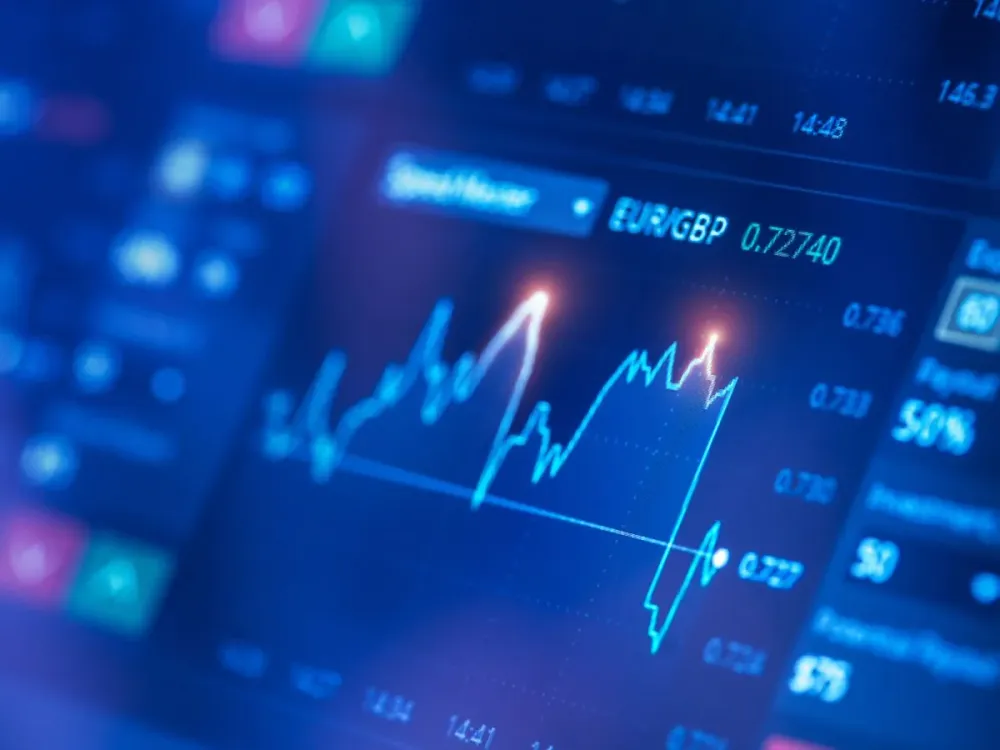
Close-up of a stock market graph showing fluctuating trends and numbers.
What is Proprietary Trading, and How Does It Work?
Proprietary trading, also known as prop trading, is a form of trading where financial firms and traders invest their capital to make profits. Unlike other investors, prop traders do not manage outside investments or client funds. Instead, they use the firm's own money and resources to identify and capitalise on market opportunities.
Prop trading firms can range from small operations with just a few traders to large investment banks with hundreds of proprietary traders. These firms give traders access to sophisticated trading platforms, analytics, data feeds, leverage, and their capital to trade with. In return, the traders' profits go back to the firm.
How Proprietary Trading Firms Operate
Prop trading groups typically operate as independent units within or affiliated with larger financial institutions. They have a separate governance structure and compensation scheme designed to incentivise traders to generate strong risk-adjusted returns.
The best prop firms provide everything traders need to identify and execute profitable trades, including:
- Capital - Firm capital to trade with, often starting around $1-5 million per trader.
- Infrastructure - Desks, equipment, data feeds, and fast order execution platforms.
- Analytics - Quantitative models, trading signals, risk analysis, and AI to enhance decision-making.
- Mentorship - Guidance from senior prop traders in the group.
In return, prop traders generally receive a percentage of their trading profits as compensation. Their payout can range from 20-250%, sometimes with a base salary component. The firm keeps the remaining profits the traders generate.
Why Financial Institutions Engage in Proprietary Trading
There are a few key reasons large banks and other financial companies operate prop trading groups:
Revenue Generation - Prop trading can produce substantial trading revenue and diversify income streams. Firms allocate some capital specifically for these groups to grow through speculative trading.
Market Making - Prop traders facilitate liquidity and price discovery by providing bids and ask quotes in their trades. This market-making activity generates small profits for the firm but also helps maintain orderly markets.
Talent Incubation - The high-risk, high-reward nature of prop trading allows firms to identify and develop top trading talent within their ranks to take on larger leadership roles.
Investment Insights - Proprietary trading provides firsthand intelligence into market dynamics that can inform other investment decisions across the firm.
However, prop trading also comes with significant risk since poor trading decisions can lead to substantial losses. Firms must actively monitor and manage their risk exposure from these activities.
Common Prop Trading Strategies
Proprietary trading groups employ various algorithms and strategies spanning many asset classes to identify profitable trades, including:
Equity Market Neutral
Using quantitative models and data analysis, equity market-neutral traders spot pricing anomalies between related stocks and securities to generate returns uncorrelated with general market moves. For example, they may go long stocks within an industry group that are expected to outperform while simultaneously shorting index ETFs as a hedge. Or they might capitalise on short-term differentials in prices of stock pairs identified through statistical correlations.
This strategy relies heavily on machine learning algorithms ingesting alternative data to discover alpha signals. The traders then leverage computational power to act rapidly on small pricing deviations. Risk management around portfolio construction and position sizing is vital to prevent unhedged factors or single stock risk from outweighing the marginal gains across a basket of trades.
Statistical Arbitrage
This high-frequency trading strategy aims to capitalise on short-term price discrepancies and market inefficiencies across securities through quantitative modelling and pattern recognition. For instance, prop traders may spot pricing differences between an index ETF and its underlying basket of stocks. Or they could find a bond trading cheaper in one public venue vs. another that they can instantly arbitrage. The key is having an analytics edge to detect mispricings faster than competitors.
Strategies constantly evolve as markets change, so continual research around new signals is imperative. Since opportunities may only persist for seconds, these prop traders also need cutting-edge order execution systems to enter and exit trades with minimal latency. Above-average processing speed allows them to exploit more fleeting anomalies before the gaps close.
Merger Arbitrage
Merger arb traders analyse announced merger deals to capture the spread between a target company’s current price and the acquisition price offered by the buyer. Since pending deals have some risk of falling through before closing, targets tend to trade at a discount to the bid price. Prop traders aim to profit off this spread while hedging risks if deals break.
To size positions correctly, traders must assess deal closing probabilities based on regulatory hurdles, financing risks, shareholder votes and other factors. Detailed legal and financial analysis is essential to handicap merger outcomes. Hedging other macro variables impacting spreads, such as interest rate moves, is also vital to locking in transaction gains.
Options Market Making
Providing liquidity by trading long and short option contracts generates small bid-ask spread profits. Prop traders also hedge, model volatility, and incorporate other options strategies.
Cryptocurrency Trading
With their capital, prop traders can take outright long or short positions in digital currencies and exploit pricing differentials across cryptocurrency exchanges.
In general, prop traders utilise data-driven, computational techniques combined with discretionary judgment honed through experience. The most successful traders have strong risk management skills to size positions appropriately and cut losses when trades go against them.
Key Differences From Other Trading Roles
Proprietary traders have some unique attributes that distinguish them from related finance roles:
1. Capital at Risk
Unlike fund managers, prop traders have the discretion to take on substantial risk by trading the firm’s capital. Strong risk controls are vital.
2. Focused on Shorter Time Horizons
Prop traders aim to capitalise on shorter-term mispricings and market moves, not long-term investments. Strategies target daily to monthly horizons.
3. Less Regulation
Prop traders avoid regulatory burdens faced by investment advisors, bankers, and fund managers around client activities.
4. Potentially Enormous Upside
There is no cap on how much a proprietary trader can make if they have outlier success. But the downside is getting fired for poor performance.
5. Solo Endeavor, Team Support
While prop trading is largely an individual effort, traders benefit from firm capital, infrastructure, and collaborating with colleagues.
In essence, prop traders are intrapreneurs executing speculative trades inside financial institutions. They have more autonomy than portfolio managers but take on outsized business risks, which is reflected in their P&L.
How Proprietary Trading Differs from Other Investing Activity
Proprietary trading differs considerably from more widely known trading roles that asset managers, hedge funds, and individual investors engage in:
Proprietary Trading
- Trade the firm’s capital
- Take on substantial risk
- Focus on short-term horizons
- Traders are major principals
- Large potential profits and losses
Investment Management
- Manage client investments
- Moderate risk due to fiduciary duty
- Long, medium, and short-term horizons
- Clients are principals
- Fees for assets under management
Hedge Fund Trading
- Trade client funds in a partnership
- Flexibility to take on more risk
- Varying investment horizons
- Client-limited partners are principals
- Earn incentive fees on profits
Individual Trading
- Trade personal savings
- Accountable only to oneself
- Varying short and long positions
- Individual traders are the only principals
- Limited assets to invest and lose
Because prop traders use the firm’s capital to make speculative bets purely for profits, they have more latitude and appetite for risk than portfolio managers, who handle other people’s money.
At the same time, individual active traders cannot match the scale and potential upside proprietary traders enjoy, given the vast resources and leverage their employer provides.
The Evolution of Proprietary Trading Groups
Prop trading groups have undergone structural shifts since the 2008 financial crisis as regulations and market dynamics transformed:
- Pre-2008 - Major banks like Goldman Sachs, Morgan Stanley and JP Morgan had large in-house proprietary trading groups speculating across assets from stocks to commodities using the firm’s balance sheet. Some desks became enormously profitable right before the crisis.
- Volcker Rule Impact - US regulations prohibited bank holding companies from speculative prop trading, given concerns about systemic risk. Firms had to either shut proprietary units or spin them off into separate entities by 2014. Most bank prop desks dissolved or downsized considerably.
- Rise of Independent Prop Shops - Hundreds of independent proprietary trading firms opened to continue speculative trading activity outside large banks. Many smaller shops also emerged. High-frequency trading firms also grew rapidly during this period.
- Consolidation - With profits harder to generate after increased automation and lower market volatility, smaller prop shops struggled to gain scale. The 2010s saw significant consolidation, with larger firms acquiring smaller competitors.
- Tech Focus - By the early 2020s, the most successful prop trading firms heavily invested in data science and quantitative research to improve trade signals. Computing power and trader productivity became vital edges.
Although tech-centric prop trading outside big banks largely replaced old Wall Street trading rooms, the core model of firms backing traders with capital and infrastructure persists. This alignment of interests between traders and their backers continues driving capital markets activity.
Key Takeaways
- Proprietary trading involves firms investing their own capital in speculating in markets rather than handling client funds.
- Prop traders get access to data, analytical tools, trading infrastructure and a firm’s capital to generate returns.
- Compensation is based on trader profits, with payouts of around 20-50% of what they produce.
- Prop trading drives revenues and also provides market liquidity benefits to the backing firm.
- These independent trading groups take on considerable risks, so strong oversight is critical.
- Proprietary traders use diverse data-driven strategies across stocks, derivatives, currencies and digital assets.
- Successful prop traders possess strong analytical abilities, risk management skills, mental toughness and relentless competitive drive.
- While demanding, prop trading offers monetary upside and autonomy, exceeding most finance roles.
In a capital-intensive, highly competitive industry like prop trading, only exceptional individuals and firms deploying cutting-edge technology can sustain peak performance. But for those who do, the financial rewards make the challenges worthwhile.


